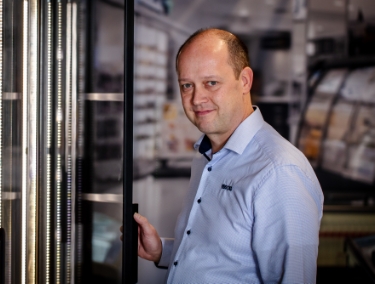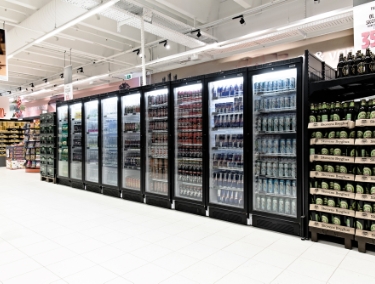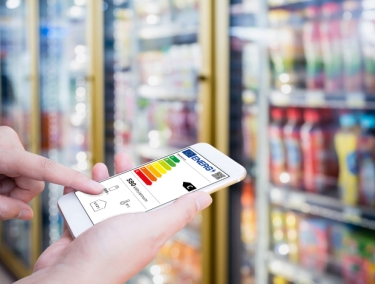How can the same display cooler appear with two different energy labels?
When business owners are looking to invest in cooling equipment, it’s a good idea to look at the energy label, which can affect future energy consumption and, not least, electricity bills. However, the energy label does not show the whole truth, as there can be big differences between consumption in a test situation and in the real world. At Vibocold, we know this, and that’s why we encourage the authorities to control the whole system in a better way.
The EU sets a number of requirements and standards for companies’ products and services. The requirements help to protect the environment, thereby building trust between businesses and customers.
This includes energy labels, which classify products from A to F depending on their energy consumption. The purpose of the labelling system is to highlight the most energy-efficient products on the market so that customers can take consumption and costs into consideration when making new purchases.
However, there’s one simple, but very significant, problem with the system:
“The Danish Safety Technology Authority is responsible for monitoring energy labelling, but they are holding back. Therefore, the authorities do not have enough control over the labelling system, and the responsibility instead lies with the individual players and manufacturers,” explains our Purchasing Manager John Karlsen.

The ABCs of energy labelling are messed up
When the responsibility for energy labelling lies with the manufacturers themselves, there is room for interpretation of the test requirements. This can lead to misleading energy labels being placed on cooling units.
“The rules are quite relaxed and there is no control over how the measurements are carried out. Legislation defines what you must and what you can do. But the challenge lies in how manufacturers relate to it and what they disclose,” says John Karlsen.
This is because there are different standards depending on the type of furniture and how it is used, and if a cooling furniture is assessed based on the wrong formula, it can easily end up in the wrong energy class.
“I can’t help but wonder why two otherwise almost identical products have completely different energy labels. It smells a bit like someone is bending the rules of measurement when a refrigerator in Energy Class B actually uses more power than one in Energy Class C,” says John Karlsen and adds:
“For example, some seem to be making the energy label a little greener by using the formula for supermarket coolers (EN 23953, ed.) for their bottle coolers (EN 22044, ed.) or by testing consumption without doorways, as is otherwise required.”

More control, less jungle law
The lack of control over energy labelling particularly affects the customers that the system is designed to help. It is virtually impossible for them to understand what is actually behind a particular energy label.
“Companies have a commercial interest in achieving a good energy rating, but when the testing of cooling units is carried out so differently, their actual energy consumption is hidden from customers. That’s why it’s important that they look at energy consumption instead of the energy label,” says John Karlsen and elaborates:
“It is frustrating that in March 2021, new and stricter energy regulations were created without securing a control body to enforce them. It puts a huge burden on manufacturers, and without controls, jungle law rules the market.”
As John Karlsen sees it, there is only one solution to the problem of ambiguous energy labelling:
“The Danish Safety Technology Authority needs to get more involved and make sure that testing is done correctly and according to the same standards. It’s the only way to tackle the problem.”
It should be quite simple!
The higher the letter grade – the lower the energy consumption. Unfortunately, that’s not always the reality.
We therefore recommend that you always check the energy label before investing in new cooling furniture.
For example, you should focus on:
- the annual energy consumption
- the energy classes
- the temperature range

Why is it important to know what the cooler will be used for?
Because we use temperature and climate classes as a reference point when testing our coolers. We usually test our products in Climate Class 3. The climate class tells you how high a temperature the cabinet cooler is built to perform optimally at.
Climate Class 3 corresponds to an ambient temperature of 25°C and 60% humidity.
The temperature class for coolers is typically tested at M1, where the temperature range is -1 to +5°C.
BUT, and most importantly, you need to know what your cooler will be used for!
For example, the recommendation is that meat, cold cuts and dairy products should be stored at a maximum of +5°C. So, if you buy a cooler that has been tested to go up to 10°C, you risk your food going bad. That’s why it’s important to buy a cooler that has been tested in exactly the right temperature and climate class.
See the overview of recommended temperatures hereFacts and figures
Understanding the energy label can be complex.
For example, you may encounter two different energy labels on the same refrigerator depending on which EN standard and test method is used.
Do you need honest advice before investing in new cooling equipment?
Contact us via the form at the bottom of the page or call us on